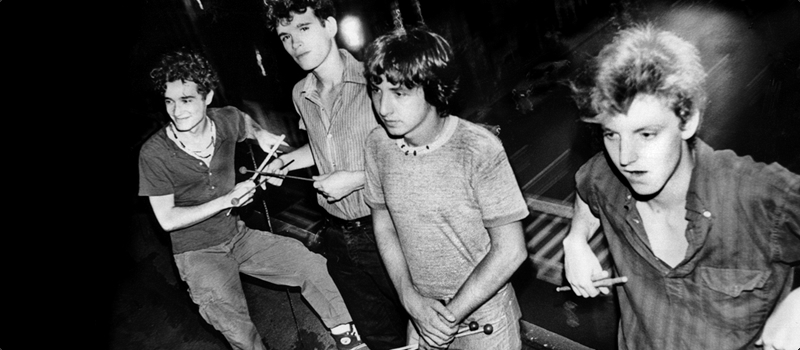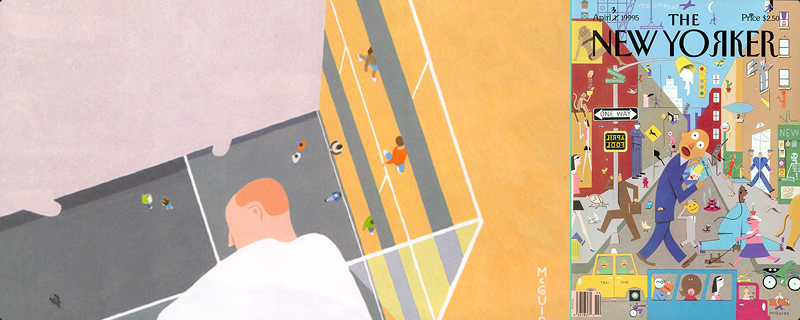Richard McGuire of Liquid Liquid
リキッド・リキッド、リチャード・マクガイアが語る
「サウンドとビジュアルの関係性」
08 5/16 UP
Interview:Paul Mittleman and Adam Weissman Translation:Shinsuke Seta


- PM :
- バンドはエド・ブラフマンのレーベルと契約し、その後99レコーズはシーンのアイコン的存在となるわけですが、当時のシーンにおけるクリエイティヴィティや活気、そしてその雰囲気というのはどのようなものだったのですか?
- The band you played in was signed to Ed Balhman's label, 99 records was such an iconic place and label. What was the scene around that like? (in terms of creativity, energy and vibe)
- RM:
- 99レコーズそのものは赤い壁といくつかのレコードラックがあるだけのとても小さなスペースで、レコードと一緒に洋服も売っていました。10人も人がいればいっぱいになるような小さな場所でしたね。当時はインポートのレコードを扱っているところがそう多くなく、99はその中のひとつでした。お店はグリニッジ・ビレッジのマクドゥーガルストリートの99番地に位置していて、60年代にはその辺りに多くのカフェやナイトクラブがあったという歴史のあるロケーションです。99レコーズにはいつも新しいモノがあって、オーナーのエドは店に来るお客さんが好む音楽を聴かせてくれました。エドのガールフレンドのジーナは洋服の販売を手掛けていて、イングランド出身の彼女が、向こうから色々なものをセレクトして持って来ていました。僕はよく店でたむろしていたんですが、そこでリック・ルービンやパブリック・イメージ・リミテッドのキース・レヴィンをはじめとした、多くの人と出会いましたよ。
- It was a very very small place with red walls and a few record racks, they sold clothes too, off to one side. If there were 10 people in there it felt crowded. There weren't many places to buy import records, 99 was one of them. It was at 99 MacDougal St. in Greenwhich Village, a very historic street, this is where all the cafes and clubs were in the 60's. The store was a place to go to hear new things. Ed would take the time to play you something he thought you would like. Ed's girlfriend Gina ran the clothes part, she was from England, they imported a lot of stuff from there. I would hang out there and listen to new records, you would bump into people, I met Rick Rubin there, and Keith Levine from PiL. New York seemed much smaller then, hard to imagine, it seems like ancient history now.
- PM :
- あなたはそれ以降もアルバムのカバーアートを手掛けていたのですか? 主な作品があれば教えて下さい。
- Did you do lots of album covers back then? If so, which ones?
- RM:
- 当時手掛けていたのはリキッド・リキッドの作品だけでしたが、その後は友達からカバーアートの制作を依頼されることもあって、ウイのカバーアートはいくつか制作しましたね。そのうちのひとつにウイラブというステレオラブとのコラボーレーション作品などもあります。
- I was only doing the Liquid records back then. I was asked to do a few more over the years mostly for friends, I did a few covers for Ui and one for an EP Stereolab did in colaboration with Ui, called Uilab.
- PM :
- 当時、NYダウンタウンのアートシーンと音楽シーンはどのように混ざり合っていたのでしょう? また、そのようなシーンにおける代表的人物は誰でしたか?
- How did the downtown art scene vs. the music scene intermingle? And who were those artists and musicians that dabbled in both?
- RM:
- アートと音楽、その両者の線引きというのはさほど重要ではありませんでした。デヴィッド・バーン、スーサイドのアラン・ベガ、ソニックユースのキム・ゴードン、彼らは皆、音楽とアートの両者を手掛けていたと言えますね。また、ジム・ジャームッシュはミュージシャンでもあるし、バスキアもそうですね。バスキアと出会った日のことは今でも覚えていますよ。ちょうどバンドの練習に彼もいたんだけど、彼との出会いはとても面白く、すぐに意気投合してその場で1分足らずのジャムセッションが始まりました。その時のバスキアはスティックでギターを弾いていましたよ。また、当時のダウンタウンのシーンと、サウスブロンクスのアート・音楽シーンとの衝突も興味深い出来事でしたね。異なるシーン、カルチャーのミックスというのはとても重要なことで、なかでもキース・へリングがオーガナイズしたクラブでのアートエキシビションはその両者をミックスさせたものでした。クラブ57とマッドクラブ、僕はこれら両方のクラブで開催されたショーに招かれたアーティストのなかの一人でした。
- The distinctions didn't matter so much. David Byrne , Alan Vega of Suicide, Kim Gordon of Sonic Youth, they all did both. Jim Jarmush was also musician. Jean Michel Basquiat was a musician. I remember one day I bumped into him on the street when I was going to a Liquid practice he came along. It was funny, we decided to play a lot of very short jams, like under a minute each. Jean was playing a guitar with a stick. What was interesting was that the 'downtown' scene was colliding with the art and music scenes of the South Bronx. That cultural mix was the important thing. There were art exhibits organized in clubs by Keith Haring that would mix it all up. I was in a few of those shows he put together at Club 57 and the Mudd Club.


